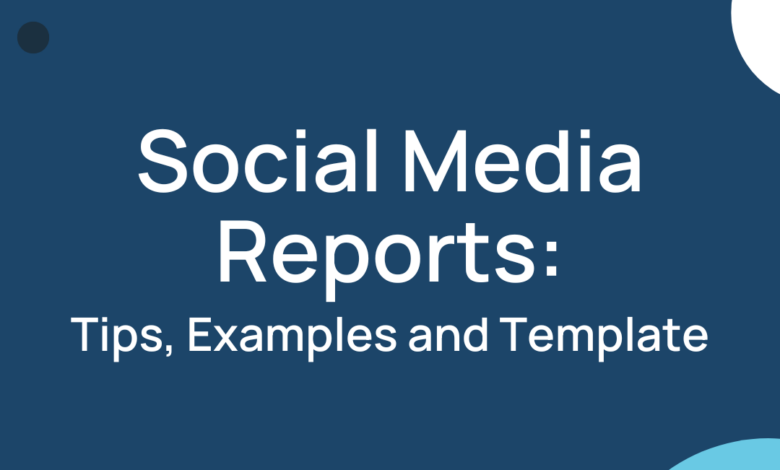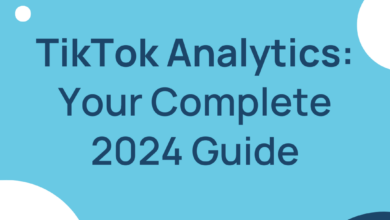Social Media Reports: Tips, Examples and Template

Welcome to the ultimate playbook for mastering the art of social media reports, where data meets strategy in a dance that can skyrocket your online presence to new heights. Gone are the days of aimless posting and hoping for the best. In the digital arena, knowledge is power, and power comes from understanding the story your data is eager to tell. With the right insights, every click and like becomes a step towards achieving your goals.
But reporting on your social media performance isn’t just for you—There are other stakeholders who’ll want to know how social channels are getting along and what impact they’re having on the business. So, you need to know how to build a report and what to include to help clients or stakeholders understand the return they’re getting on their social investment.
What is a social media report?
A social media report is a document that compiles data from your social media accounts to provide an overview of your social media performance. It’s a snapshot of how your strategy is playing out in the digital realm, offering insights into what’s working, what’s not, and where there’s room for improvement. These reports can vary in complexity, from simple weekly updates to comprehensive analyses covering longer periods.
At its core, a social media report aims to translate raw data into actionable insights. It goes beyond just tallying likes and followers; it delves into engagement rates, audience demographics, content reach, and the effectiveness of different platforms and campaigns. By doing so, it helps marketers and businesses understand the impact of their social media efforts on their overall marketing goals and objectives.
Effective social media reporting involves not just data collection but also analysis and interpretation. It answers key questions about your social media strategy, such as:
- Which types of content resonate most with your audience?
- How are your social media campaigns contributing to your business goals?
- What are the best times to post to engage your target audience?
- How does your social media performance compare to industry benchmarks or competitors?
By providing answers to these questions, social media reports empower businesses to make informed decisions, tweak their strategies for better results, and demonstrate the ROI of their social media efforts to stakeholders. Whether you’re a small business owner, a social media manager, or part of a larger marketing team, mastering the art of social media reporting is crucial for navigating the digital landscape effectively.
7 Types of Social Media Reports and When to Use Them
Social media reporting is a general term, but there are lots of subsets of reports you can create. The type of report you create, how you present it, and what you include on the report depends entirely on who will be reading it.
Are you doing some analysis for your own information or strategy? Is this for senior management in a social media agency who want to benchmark client results? Or is this a presentation you;ll be giving to the wider business, or a client to showcase how social efforts are paying off?
Tailoring the content of the report to the audience is essential to getting your results or information across effectively.
1. Monthly Performance Reports
Monthly reports offer a regular, detailed look at your social media activities. They typically include metrics like follower growth, engagement rates, and content performance. The goal is to identify trends, assess the effectiveness of your content strategy, and make adjustments for the upcoming month. This type of report is crucial for keeping stakeholders informed about short-term results and ongoing efforts.
2. Quarterly or Annual Reviews
These reports provide a broader overview, comparing data across months or years to analyze long-term trends and the overall growth of your social media presence. They often include a deeper dive into campaign performance, audience demographics, and ROI. Quarterly or annual reviews are essential for strategic planning and aligning social media goals with business objectives.
3. Campaign-Specific Reports
Campaign-specific reports focus on the outcomes of particular marketing campaigns or initiatives. They measure success against predefined objectives, such as increasing brand awareness or driving sales, and include relevant metrics like conversion rates, engagement, and reach. These reports are valuable for understanding what elements of the campaign worked well and what could be improved in the future.
4. Social Media Audit Reports
A social media audit report offers a comprehensive evaluation of your entire social media strategy. It covers account optimization, content analysis, competitive benchmarking, and more. The goal is to identify strengths, weaknesses, and opportunities for improvement across your social media channels. This type of report is pivotal for businesses looking to refine their strategy and ensure their efforts are aligned with their overall marketing goals.
5. Platform-Specific Reports
Given the unique nature of each social media platform, creating reports that focus on a single platform can be incredibly insightful. For instance, an Instagram report might delve into Stories performance, post engagement, and hashtag effectiveness, while a LinkedIn report could focus on B2B engagement metrics and lead generation efforts. Platform-specific reports allow marketers to tailor their strategies to the nuances of each platform.
6. Engagement and Interaction Reports
These reports zero in on how audiences are interacting with your content. Metrics such as likes, comments, shares, and direct messages are analyzed to gauge audience sentiment and engagement levels. Understanding these interactions can help businesses develop more compelling content and foster a stronger community around their brand.
7. Competitive Analysis Reports
Competitive analysis reports examine your social media performance in relation to your competitors. They can reveal insights about your market position, highlight competitive advantages, and identify areas for improvement. By understanding how your efforts stack up against others in your industry, you can make strategic adjustments to stand out.
Each type of social media report offers unique insights and benefits, helping businesses and marketers to measure performance, make informed decisions, and achieve their social media objectives. Incorporating a mix of these reports into your strategy, especially when utilizing comprehensive tools like Locowise, can enhance your understanding of your digital presence and drive meaningful improvements.
Why not add a little AI and predictive analytics into your reporting mix? Try a free trial of Locowise!
What should you include in a social media report?
Creating a valuable social media report involves including a variety of elements that together offer a complete picture of your social media performance. Here’s what should be included in your social media report to ensure it’s both comprehensive and insightful:
1. Executive Summary
Start with an executive summary that provides a high-level overview of your social media activities and their alignment with your overall marketing goals. This section should highlight key findings, successes, and areas for improvement.
2. Goals and Objectives
Clearly state the goals and objectives of your social media strategy. This could include increasing brand awareness, boosting engagement, driving website traffic, or generating leads. Providing this context helps stakeholders understand the purpose behind the data.
3. Methodology
Briefly describe the methods used to collect and analyze the data. This might involve explaining the use of specific social media analytics tools, the time frame of the data collected, and any assumptions made during the analysis.
4. Key Performance Indicators (KPIs)
Detail the Key Performance Indicators (KPIs) that are most relevant to your goals. These could include metrics such as engagement rate, follower growth, click-through rate, conversion rate, and reach. Include both quantitative and qualitative data to paint a full picture.
5. Platform-Specific Data
Provide a breakdown of performance by platform, including Facebook, Instagram, Twitter, LinkedIn, and any others relevant to your strategy. For each platform, include metrics specific to that network, such as Instagram Story engagement or Twitter mentions.
6. Content Analysis
Analyze the performance of your content across all platforms. Identify which types of content (videos, blog posts, images, etc.) performed best and why. Discuss the engagement levels of different content formats and any patterns or trends that emerged.
7. Audience Insights
Include insights into your audience demographics, interests, and behavior. Understanding your audience’s preferences and how they engage with your content is crucial for tailoring your strategy to meet their needs.
8. Comparison to Previous Periods
Compare your current performance to previous periods to identify trends, growth patterns, or areas where performance may have dipped. This analysis can help inform future strategies and set realistic goals.
9. Competitor Benchmarking
If applicable, include a section on how your social media performance stacks up against competitors. This benchmarking can provide valuable context and help identify areas where your brand can differentiate itself.
10. Recommendations and Next Steps
Conclude your report with actionable recommendations based on your findings. Outline next steps for addressing areas of improvement, capitalizing on successful strategies, and adjusting your approach to better meet your social media goals.
11. Include Relevant Context
Finally, it’s important to remember that a piece of data may only tell part of the story. Make sure you include context on figures where it is relevant. For example, a spike or dip in performance may have a perfectly valid reason. Or perhaps a metric that looks concerning at first glance isn’t as indicative of performance as it may seem. As the reporter, it’s your job to make sure the report can be understood fully with context where needed.
Including these components will ensure your social media report is not only informative but also actionable, providing a solid foundation for strategic decision-making and continuous improvement in your social media efforts.
Try This Social Media Report Template
Here’s a handy template—Not all of these items may be necessary, but it’s useful for putting some structure around your reporting:
1. Executive Summary
- Brief overview of social media performance
- Key achievements and areas for improvement
- Summary of recommendations
2. Introduction
- Purpose of the report
- Reporting period
- Overview of social media goals and objectives
3. Methodology
- Description of data collection and analysis methods
- Tools and platforms used
4. Goals and Objectives Review
- Detailed list of social media goals and objectives for the period
- Status of each goal (achieved, in progress, not achieved)
5. Key Performance Indicators (KPIs)
- Engagement: Likes, comments, shares, etc.
- Reach and Impressions
- Follower Growth
- Click-Through Rates (CTR)
- Conversion Rates
- Any other relevant KPIs
6. Performance by Platform
Facebook:
- Summary of Facebook performance
- Key metrics and insights
Instagram:
- Summary of performance
- Key metrics and insights
Twitter:
- Summary of performance
- Key Twitter metrics and insights
LinkedIn:
- Summary of performance
- Key metrics and insights
7. Content Analysis
- Overview of content strategy
- Performance of content types (e.g., videos, images, blog posts)
- Top-performing posts and content analysis
- Recommendations for content strategy
8. Audience Insights
- Demographic information
- Behavior and engagement patterns
- Insights into audience preferences
9. Comparison to Previous Periods
- Analysis of growth and performance trends
- Comparison of current vs. previous periods
10. Competitive Benchmarking
- Overview of competitor landscape
- Comparison of key metrics with competitors
11. Challenges and Opportunities
- Summary of challenges faced during the reporting period
- Opportunities identified for improvement or growth
12. Recommendations and Action Items
- Specific recommendations based on analysis
- Action items and strategies for the next period
13. Conclusion
- Final thoughts and overview of next steps
14. Appendices (if applicable)
- Detailed data tables or charts
- Additional supporting information
Get beautifully designed reporting at the click of a button with Locowise. Reduce the manual work you put into regular social reports, and get detailed social audits to benchmark social performance. Start your free trial!
Tips for Delivering Social Media Reports That Resonate and Impress
Define Clear Objectives
Start with a clear understanding of what you aim to achieve with your social media efforts and how those goals align with your overall business objectives. This clarity will guide what data you collect and how you interpret it.
Choose the Right Metrics
Select metrics that directly reflect your social media objectives. Avoid vanity metrics that look impressive but don’t offer real insight into your performance or business impact. Focus on engagement, conversion rates, and other metrics that show how well your content resonates with your audience.
Use Visuals to Tell the Story
Incorporate charts, graphs, and infographics to make your data more accessible and engaging. Visuals can help stakeholders quickly grasp key points and trends without wading through dense tables or lists.
Benchmark Your Performance
Compare your current performance against previous periods to track progress over time. Also, consider benchmarking against industry standards or competitors to provide context and highlight areas where you excel or need improvement.
Provide Context for the Data
Numbers don’t tell the whole story on their own. Offer insights into what might have influenced your social media performance, such as changes in strategy, external events, or platform algorithm updates. This context turns raw data into meaningful analysis.
Highlight Successes and Learnings
Celebrate wins by showcasing what worked well and why. Equally important, openly discuss what didn’t work and what you’ve learned from it. This honest evaluation fosters a culture of continuous improvement.
Offer Actionable Recommendations
Don’t just report on the past; use your insights to guide future actions. Provide specific, actionable recommendations based on your findings to improve strategy, content, engagement, or any other aspect of your social media presence.
Tailor Reports to Your Audience
Customize the depth and focus of your reports based on the needs and interests of your audience, whether they’re executives, the marketing team, or other stakeholders. Highlight the information that’s most relevant to them.
Automate Data Collection Where Possible
Use tools and software to automate the collection and basic analysis of data. This saves time and allows you to focus on the more nuanced aspects of analysis and strategic planning.
Regular Review and Adaptation
Social media is an ever-evolving landscape. Regularly review your reporting strategy and adapt it based on new platforms, changing objectives, and the shifting interests of your audience.
Educate Your Audience
Use the report as an opportunity to educate stakeholders about social media best practices, the significance of certain metrics, and the impact of social media on the broader business goals.
By following these tips, your social media reports can become more than just a monthly or quarterly obligation. They transform into strategic tools that drive decision-making, foster transparency, and contribute to continuous improvement in your social media efforts.
Fast, Multi-Format Social Media Reporting at Your Fingertips
With Locowise, social media agencies can cut down the hours spent on compiling reports, thanks to our streamlined analytics and automated reporting features. Transform exhaustive data collection into a swift, seamless process, freeing up your team to focus more on strategy and less on spreadsheet wrangling.
Don’t let your social media efforts go unnoticed. Join the ranks of savvy marketers who leverage Locowise to stay ahead of the curve. Try it yourself for free here!
The post Social Media Reports: Tips, Examples and Template appeared first on Locowise Blog.
Source link




